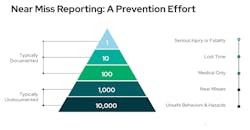How Companies Can Use the Safety Pyramid to Improve Their Culture
For over 90 years, Herbert Henrich’s “safety pyramid” (see Figure 1) has been a cornerstone of safety management. It helps safety professionals visualize various safety incidents based on their frequency and severity.
The high-level thinking: at many organizations, the most severe incidents (i.e., workplace fatalities) are often preceded by thousands of near misses and generally unsafe behaviors. By targeting these latter cases early, leaders can avoid worst-case scenarios.
Like many frameworks, though, it’s often tough to translate theory into practice. In this piece, I’ll explain how leaders can use the logic of the safety pyramid to improve their safety program and workplace culture. But first, let’s take a closer look at the pyramid itself.
Background: Understanding Heinrich’s Safety Pyramid
The safety pyramid groups incidents into five categories, starting with the most frequent and least severe occurrences:
- Unsafe behaviors and hazards: These are incidents that could happen every day, from doing construction work without PPE to improperly using a forklift on a crowded job site.
- Near misses: These are incidents in which a worker narrowly avoided injury. For instance, a worker might have tripped over an extension cord but managed not to fall.
- Medical-only incidents: These include injuries like small cuts or bruises, which might require medical attention but don’t result in lost workdays.
- Lost time incidents: These include injuries like fractures or broken limbs, which often require lost workdays or significant medical treatment.
- Serious injuries or fatalities: These are the most severe incidents; they result in permanent disability or death.
As I noted earlier in this piece, the more severe an incident, the more likely it was preceded by something far less serious. For every on-the-job fatality, there might have been 10,000 unsafe behaviors or hazards in the lead-up.
A word of caution, though: don’t interpret this logic as blaming workers for any serious incidents that arise. In fact, at many organizations, the outsize frequency of near misses, unsafe behaviors, and hazards indicates a need for a stronger safety culture – something that’s under the purview of dedicated safety professionals.
It’s also worth noting that most organizations only document the most serious incidents. That means they lack insight into lower-tier incidents that they could easily prevent. And a lack of prevention can have dangerous knock-on effects.
So how can organizations reduce these bottom-of-pyramid incidents and strengthen their safety culture? In the rest of this piece, I’ll share four steps that can help.
Step 1: Conduct a Safety Audit
Many companies focus primarily on lagging indicators (i.e., data collected after an incident has occurred). While these are often important for regulatory compliance and historical safety analysis, lagging indicators alone don’t provide a complete picture of safety gaps. They only explain what went wrong – not what might go wrong in the future.
With a safety audit, you can review your safety data collection methods to provide a stronger foundation for analysis and prevention. That means tracking leading indicators on your worksite, like unsafe behaviors, common hazards, and near misses. If someone almost slips on an unmarked wet spot, that could point to the potential for an actual fall later on that could result in injury.
Step 2: Implement Reporting Software
Once you know what data to collect going forward, equip your staff with comprehensive software that enables real-time reporting and analysis. My recommendation? Use mobile, cloud-based software so workers can report incidents as soon as they arise. This way, they won’t have to wait until they’re at a computer to fill out a form.
As a best practice, encourage workers to report all types of incidents so you can capture the full state of safety at your organization.
On the back end, cloud connectivity will ensure that no reports fall through the cracks. What’s more, the right tool will come with analytics dashboards to help you identify patterns and trends. This way, you can proactively address potential hazards before they result in serious incidents. For instance, if workers frequently slip or trip in a particular area of a warehouse, this could signal a need for better “wet floor” or “watch your step” signage.
Step 3: Engage the Whole Organization
A successful safety culture requires buy-in from both leadership and frontline workers. With engagement at every level, safety can become a core value for your organization.
One great starting point is a robust safety training program. The challenge, though, is finding a way to make each lesson both accessible and engaging. If workers don’t grasp your safety protocols, they’re at risk of injury or worse.
Mobile-based safety training programs are a solid way to meet workers where they are. These programs allow workers to access training materials anytime, anywhere. And with bite-sized, easily digestible modules, workers can complete training at their own pace. This approach enables continuous learning and keeps safety top of mind.
Leaders like supervisors and foremen can have an impact as well. The key is to make sure they display good safety habits every day. These folks are often role models for more junior workers. They can encourage their direct reports to follow safety protocols and protect each other in the process.
If an incident does occur, make sure workers know how to complete a report in-app – and be transparent about what they should expect afterward. Keep them updated on progress with digital notifications, and make sure they know who to go to for more information. The more transparent you are, the more workers will trust in the culture you’ve built.
Step 4: Monitor and Adjust
As you execute the above steps, make sure to continuously monitor your organization’s safety performance. EHS software can be a powerful asset here; it lets you track safety progress in real time, from training module completion rates to safety interventions.
From here, you can take an iterative approach to your safety program. Consider making incremental changes as needed to your training curriculum, data collection processes, etc. This way, you can gradually develop a safety culture that proactively responds to the needs of your organization.
Preventive Strategies Have a Huge Impact
The safety pyramid has been around for decades, but it still holds a lot of value today. The key to translating theory into action is a multipronged strategy to target bottom-of-pyramid incidents before they snowball.
The steps we’ve outlined here help organizations do just that. By addressing serious safety issues at their root, organizations can better protect their workers and manage overall risk.
About the Author

Jade Hendrix
Jade Hendrix is Sr. Director, Product Management at KPA. KPA provides Environment, Health & Safety (EHS), and Workforce Compliance software and services for a wide range of businesses.

